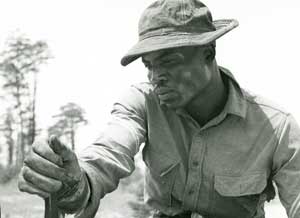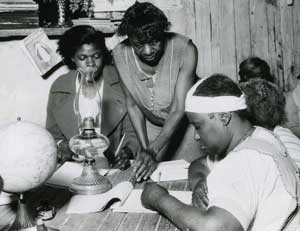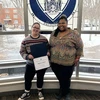Guest Appearances Accompanying Exhibit:
Beltsville, Md., May 1940: Enrollee at control of road surfacing roller (image cropped here). National Archives, Washington, D.C., 110 (full photo>>) Before 1936, the Civilian Conservation Corps (CCC) was largely an organization for whites, especially in Southern states, despite the fact that young black men had an unemployment rate twice that of white men. For example, only 1.7 percent of the CCC in Mississippi, a state with a population over 50% black, was African American. By 1938, over 10 percent of the enrollees in the CCC were black, with increased percentages around the country.
“Georgia Literacy Class” Frederick Douglass observed that the chief difference between whites and blacks was that, due to laws, policies and practices that enforced black illiteracy and poverty, only whites could read. In the 1930s, approximately one million African Americans attended literacy classes offered by the Works Progress Administration (WPA) and other government programs, reducing black illiteracy rates substantially.
|
Many Americans associate African American freedom with well-known historical events: the Emancipation Proclamation; the post-Civil War constitutional amendments ending slavery and defining citizenship; the 1954 Brown versus Board of Education Supreme Court decision ordering school desegregation; and the Civil Rights Movement of the 1950s and ’60s.
However, African Americans asserted their rights as citizens in a number of ways, a message that is chronicled through a new exhibit, “Claiming Citizenship: African Americans and New Deal Photography,” available for free viewing in SUNY Fredonia’s Reed Library from now until Oct. 15.
The photographs in “Claiming Citizenship,” curated by historian Rickie Solinger, show that many African Americans claimed significant new freedoms during the 1930s. The New Deal programs that President Franklin Roosevelt designed in response to the economic ravages of the Great Depression did not challenge segregated schools, hospitals or other forms of institutionalized racism. Nevertheless, African Americans took opportunities created by government programs in the 1930s to:
- Take care of their families
- Earn a living wage
- Be educated persons
- Hold professional positions
- Possess economic security
- Receive health care
- Possess cash‐money and purchase goods
- Engage in civic life
- Vote
- Have a publicly acknowledged history
The New Deal-era photographs in “Claiming Citizenship” capture African Americans in these activities. Grouping them in this way illustrates that daily acts can take on political overtones. In some respects, these individuals laid the foundations for the Civil Rights Movement; indeed, the people in these photographs might well have been the parents of civil rights activists of the 1960s. Many African American beneficiaries of New Deal programs undoubtedly passed on to their children and grandchildren their determination to possess full citizenship rights.
“Claiming Citizenship” also challenges viewers to transition from the past to the present. By raising important questions about what experiences and which rights define citizenship in the United States in the 1930s, these photographs invite visitors to reflect on the rights and privileges of today’s citizens.
|
In addition to the exhibit, the public is welcome to attend two complementary presentations, both of which are free and will be held in Reed Library’s Japanese Garden area:
- Christopher Robert Reed, “The Depression Comes to the South Side,” on Sept. 13 from 6 to 7 p.m.
- Rickie Solinger, “What Citizenship Looks Like — 1930s and Today,” on Sept. 25 from 6 to 7 p.m.
The exhibit and the presentations have been sponsored by SUNY Fredonia’s Convocation Committee, Vice President for Academic Affairs, Dean of the College of Arts and Sciences, Interdisciplinary Studies Program and History Department.







